What We’re Reading: June 16th
Review: How does a plant orchestrate defense in time and space? Using glucosinolates in Arabidopsis as case study
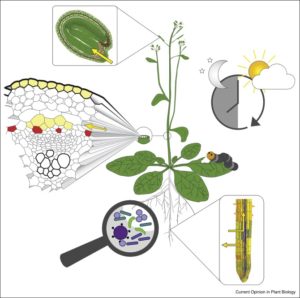 Plants, like human societies, must live with the inherent conflict between investing in defense and investing in growth and infrastructure. Burrow and Halkier provide an interesting and highly readable overview of the strategies by which Arabidopsis optimizes the production and distribution of glucosinolates, key defense compounds. This would be an excellent article to show students the elegance with which plants manage their resources. Curr. Opin. Plant Biol. 10.1016/j.pbi.2017.04.009 Tags: Biochemistry, Biotic Interactions, Education and Outreach, Metabolism
Plants, like human societies, must live with the inherent conflict between investing in defense and investing in growth and infrastructure. Burrow and Halkier provide an interesting and highly readable overview of the strategies by which Arabidopsis optimizes the production and distribution of glucosinolates, key defense compounds. This would be an excellent article to show students the elegance with which plants manage their resources. Curr. Opin. Plant Biol. 10.1016/j.pbi.2017.04.009 Tags: Biochemistry, Biotic Interactions, Education and Outreach, Metabolism
The sequences of 1,504 mutants in the model rice variety Kitaake facilitate rapid functional genomic studies
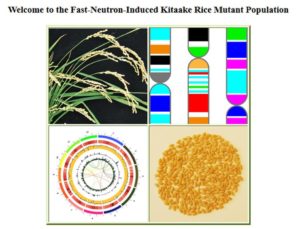 Li et al. describe an important new genetic resource, a huge database of Kitaake rice mutants. Kitaake is a short-generation variety of Oryza sativa L. ssp. japonica well suited for genetic studies. The authors sequenced more than 1500 fast-neutron-induced mutants and identified more than 91,000 mutations affecting 58% of all rice genes. They identified single-base substitutions, deletions, insertions, inversions, translocations and tandem duplications, resulting in many useful loss-of-function mutations. The database and seed ordering information are at Kitbase. Plant Cell 10.1105/tpc.17.00154 Tags: Applied Plant Biology, Genetics, Genomics
Li et al. describe an important new genetic resource, a huge database of Kitaake rice mutants. Kitaake is a short-generation variety of Oryza sativa L. ssp. japonica well suited for genetic studies. The authors sequenced more than 1500 fast-neutron-induced mutants and identified more than 91,000 mutations affecting 58% of all rice genes. They identified single-base substitutions, deletions, insertions, inversions, translocations and tandem duplications, resulting in many useful loss-of-function mutations. The database and seed ordering information are at Kitbase. Plant Cell 10.1105/tpc.17.00154 Tags: Applied Plant Biology, Genetics, Genomics
Architecture and permeability of post-cytokinesis plasmodesmata lacking cytoplasmic sleeves ($)
 Plasmodesmata are pores between cells through which viruses, proteins, small RNAs and other molecules can pass. The pores are usually described as being lined with a layer of plasma membrane with a tube of endoplasmic-reticulum membrane through the center. These membranes and associated proteins are crucial to regulate transport through the plasmodesmata. Nicolas et al. imaged plasmodesmata using electron tomography, a tool that has the resolution of transmission electron microscopy but allows 3D reconstructions of structures. They found that during cell differentiation, plasmodesmatal anatomy changes. In particular, shortly after cell division the membrane layers are more tighly appressed and appearing nearly closed (Type I plasmodesmata), but later show a much more open structure (Type II plasmodesmata). In spite of their occluded appearance Type I plasmodesmata allow passage of small molecules. Nature Plants 10.1038/nplants.2017.82 Tags: Cell Biology, Transport
Plasmodesmata are pores between cells through which viruses, proteins, small RNAs and other molecules can pass. The pores are usually described as being lined with a layer of plasma membrane with a tube of endoplasmic-reticulum membrane through the center. These membranes and associated proteins are crucial to regulate transport through the plasmodesmata. Nicolas et al. imaged plasmodesmata using electron tomography, a tool that has the resolution of transmission electron microscopy but allows 3D reconstructions of structures. They found that during cell differentiation, plasmodesmatal anatomy changes. In particular, shortly after cell division the membrane layers are more tighly appressed and appearing nearly closed (Type I plasmodesmata), but later show a much more open structure (Type II plasmodesmata). In spite of their occluded appearance Type I plasmodesmata allow passage of small molecules. Nature Plants 10.1038/nplants.2017.82 Tags: Cell Biology, Transport
Abscisic acid Antagonist 1 (AA1): A ray of hope for extending shelf life of leafy vegetables ($)
 Abscisic acid (ABA) is one of the phytohormones that plays a pivotal role in a plant’s life from germination to senescence, and it drew additional attention of researchers owing to its involvement in abiotic stress. Leaf senescence is a natural phenomenon but if this process can be delayed by non-toxic means, it may have a great implication in agricultural products especially for leafy vegetables where post-harvest life is a critical factor. The work presented by Ye et al. offers a hope in this direction. The authors identified a broad-spectrum antagonist of ABA that they christened as ABA ANTAGONIST1 (AA1). The advantages associated with AA1 as compared to previously identified ABA antagonist are its (i) binding ability to a broad range of ABA binding receptor and (ii) cost effectiveness. It would be interesting to see how AA1 can be used in agriculture and to extend the shelf life of leafy vegetables because ABA is not the only hormone that causes senescence. AA1 also holds promise for researchers working on ABA-related work. (Summary by Sudhakar Srivastava) Plant Physiol. 10.1104/pp.16.01862 Tags: Biochemistry, Signals and Responses
Abscisic acid (ABA) is one of the phytohormones that plays a pivotal role in a plant’s life from germination to senescence, and it drew additional attention of researchers owing to its involvement in abiotic stress. Leaf senescence is a natural phenomenon but if this process can be delayed by non-toxic means, it may have a great implication in agricultural products especially for leafy vegetables where post-harvest life is a critical factor. The work presented by Ye et al. offers a hope in this direction. The authors identified a broad-spectrum antagonist of ABA that they christened as ABA ANTAGONIST1 (AA1). The advantages associated with AA1 as compared to previously identified ABA antagonist are its (i) binding ability to a broad range of ABA binding receptor and (ii) cost effectiveness. It would be interesting to see how AA1 can be used in agriculture and to extend the shelf life of leafy vegetables because ABA is not the only hormone that causes senescence. AA1 also holds promise for researchers working on ABA-related work. (Summary by Sudhakar Srivastava) Plant Physiol. 10.1104/pp.16.01862 Tags: Biochemistry, Signals and Responses
Root tip shape governs root elongation rate under increased soil strength
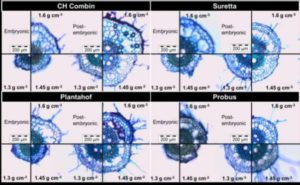 We live at a time of unprecedented insights into root anatomy, diversity, plasticity, and the genetic underpinnings of these traits. Colombi et al. examined how wheat root tip shape contributes to soil penetration and the root’s response to increasing soil density. Not surprisingly, pointier roots (with a lower ratio of tip diameter to tip length) penetrate soils more effectively than blunter roots. The authors also observed genotypic differences in root tip shape and root elongation rate, and responses to increasing soli density. These results provide another selectable root trait for future breeding projects. Plant Physiol. 10.1104/pp.17.00357 Tags: Growth Regulation
We live at a time of unprecedented insights into root anatomy, diversity, plasticity, and the genetic underpinnings of these traits. Colombi et al. examined how wheat root tip shape contributes to soil penetration and the root’s response to increasing soil density. Not surprisingly, pointier roots (with a lower ratio of tip diameter to tip length) penetrate soils more effectively than blunter roots. The authors also observed genotypic differences in root tip shape and root elongation rate, and responses to increasing soli density. These results provide another selectable root trait for future breeding projects. Plant Physiol. 10.1104/pp.17.00357 Tags: Growth Regulation
Fatty acids in arbuscular mycorrhizal fungi are synthesized by the host plant ($)
 In the symbiotic relationship between arbuscular mycorrhizal fungi and plants, the fungal partner greatly enhances the uptake of mineral nutrients (particularly phosphate), while in return it is supplied with organic carbon from the photosynthetic partner. Luginbuehl et al. investigated whether this organic carbon is exchanged solely as sugars, or whether fatty acids are also transferred from plant to fungus. Using the ram1 mutant of Medicago truncatula (RAM1 encodes a transcription factor with targets including genes involved in fatty acid biosynthesis), fatty acid synthesis mutants of the symbiotic fungus, and two-compartment systems with shared fungal hyphal networks, the authors were able to show that lipids are a major source of organic carbon delivered to the fungus. Science 10.1126/science.aan0081 You can also read a new review on this same topic by Rich et al. Trends Plant Sci. 10.1016/j.tplants.2017.05.008 Tags: Biochemistry, Biotic Interactions, Genetics
In the symbiotic relationship between arbuscular mycorrhizal fungi and plants, the fungal partner greatly enhances the uptake of mineral nutrients (particularly phosphate), while in return it is supplied with organic carbon from the photosynthetic partner. Luginbuehl et al. investigated whether this organic carbon is exchanged solely as sugars, or whether fatty acids are also transferred from plant to fungus. Using the ram1 mutant of Medicago truncatula (RAM1 encodes a transcription factor with targets including genes involved in fatty acid biosynthesis), fatty acid synthesis mutants of the symbiotic fungus, and two-compartment systems with shared fungal hyphal networks, the authors were able to show that lipids are a major source of organic carbon delivered to the fungus. Science 10.1126/science.aan0081 You can also read a new review on this same topic by Rich et al. Trends Plant Sci. 10.1016/j.tplants.2017.05.008 Tags: Biochemistry, Biotic Interactions, Genetics
Direct and indirect visualization of bacterial effector delivery into diverse plant cell types during infection
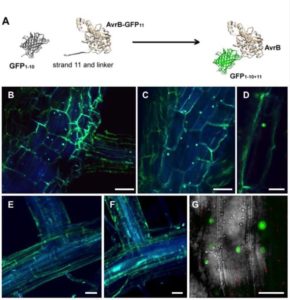 Bacterial effectors are proteins produced by bacteria and introduced into their hosts, where the effectors support successful infection by the pathogen. Effectors can function in diverse cells and cell compartments, but many studies of effector localization have relied on overexpression systems which may have artifacts. Henry et al. used the GFP strand system to visualize effector delivery during natural infection. In this system, plants are stably transformed with a gene encoding most but not all of the GFP protein, and the infecting bacteria express their effectors fused to the missing strand of the GFP structure. The GFP self-assembles in vivo, leading to fluorescence where the effector is delivered. This robust system revealed distinct effector localizations for various effectors and bacteria. Plant Cell 10.1105/tpc.17.00027 See also Park et al. Tags: Biotic Interactions, Cell Biology
Bacterial effectors are proteins produced by bacteria and introduced into their hosts, where the effectors support successful infection by the pathogen. Effectors can function in diverse cells and cell compartments, but many studies of effector localization have relied on overexpression systems which may have artifacts. Henry et al. used the GFP strand system to visualize effector delivery during natural infection. In this system, plants are stably transformed with a gene encoding most but not all of the GFP protein, and the infecting bacteria express their effectors fused to the missing strand of the GFP structure. The GFP self-assembles in vivo, leading to fluorescence where the effector is delivered. This robust system revealed distinct effector localizations for various effectors and bacteria. Plant Cell 10.1105/tpc.17.00027 See also Park et al. Tags: Biotic Interactions, Cell Biology
Highly cited classic papers from 2006
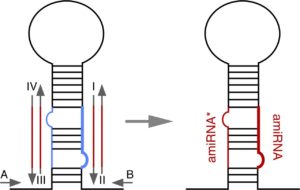 While this series highlights the latest research, a well-read scholar also needs to to know the classics. Google Scholar has a new initiative to feature highly-cited, ten-year old articles. The most-highly cited papers published in 2006 are listed by category. Plant scientists will find particular relevance in the papers from the categories Botany, Agronomy and Soil Science, and Plant Pathology. The lists reveal insights into the traits of highly-cited papers. Themes include genome sequences (e.g., Ustilago maydis, Phytophthora), analyses and curation of large gene families (e.g., ERF gene families in Arabidopsis and rice), new methods and tools (gene silencing by artificial miRNAs, gene cloning with GATEWAY vectors), identification of key trait-conferring genes (e.g., submergence tolerance by Sub1A) and breakthroughs in fundamental insights (e.g., ROS production and scavenging in chloroplasts, suppression of plant defenses by bacterial effectors). Here’s a chance to catch up with these truly classic papers you may have missed the first time around. Happy reading! (Thanks to Rubén Rellán Álvarez for the tip.) Tags: Education and Outreach
While this series highlights the latest research, a well-read scholar also needs to to know the classics. Google Scholar has a new initiative to feature highly-cited, ten-year old articles. The most-highly cited papers published in 2006 are listed by category. Plant scientists will find particular relevance in the papers from the categories Botany, Agronomy and Soil Science, and Plant Pathology. The lists reveal insights into the traits of highly-cited papers. Themes include genome sequences (e.g., Ustilago maydis, Phytophthora), analyses and curation of large gene families (e.g., ERF gene families in Arabidopsis and rice), new methods and tools (gene silencing by artificial miRNAs, gene cloning with GATEWAY vectors), identification of key trait-conferring genes (e.g., submergence tolerance by Sub1A) and breakthroughs in fundamental insights (e.g., ROS production and scavenging in chloroplasts, suppression of plant defenses by bacterial effectors). Here’s a chance to catch up with these truly classic papers you may have missed the first time around. Happy reading! (Thanks to Rubén Rellán Álvarez for the tip.) Tags: Education and Outreach




Leave a Reply
Want to join the discussion?Feel free to contribute!